Today we are going to dwell on agricultural nutrient pollution that is the result of extensive farming.
The Issue
The nutrients that are contained in fertilizer or manure (mostly nitrates and phosphorus) may reach water basins and cause a dramatic increase in the populations of phytoplankton and algae. As a result of the lifecycle of the two, the contaminated area will be deprived oxygen and become inappropriate for survival (OECD 127).
Apart from endangering the wildlife, nutritional pollution is very costly: it damages commercial fishing and marine farming, and the remedy is expensive. And agriculture is leading reason for this kind of pollution (OECD 68, 127).
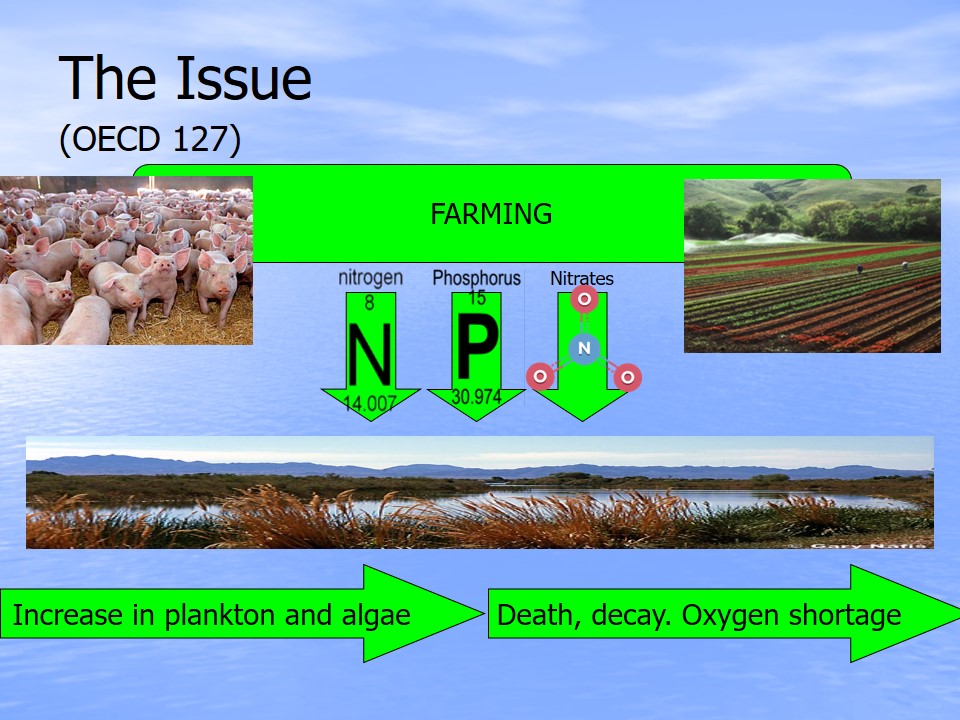

Small-scale Farming
- Advantages:
- effective to an extent;
- may be used when corresponds to the farmers’ goals.
- Disadvantages:
- limited applicability (farmer’s goals);
- not the ultimate solution.
There are several solutions suggested for the issue, and none of them is perfect: there are advantages and disadvantages to every of them. For example, individual farmers have the opportunity of contributing by keeping their farming small-scale in contrast to “factory farms” as suggested in the essay by Jeff Opperman (119). It is a valid solution if it is consistent with the farmer’s goals: smaller farms have a lesser impact on nutritional pollution, but they are also less profitable. Still, it is an intermediate solution only since smaller farms cannot keep up with the Earth’s demand for food. Also, this solution is admittedly extensive: aimed at controlling the scale.
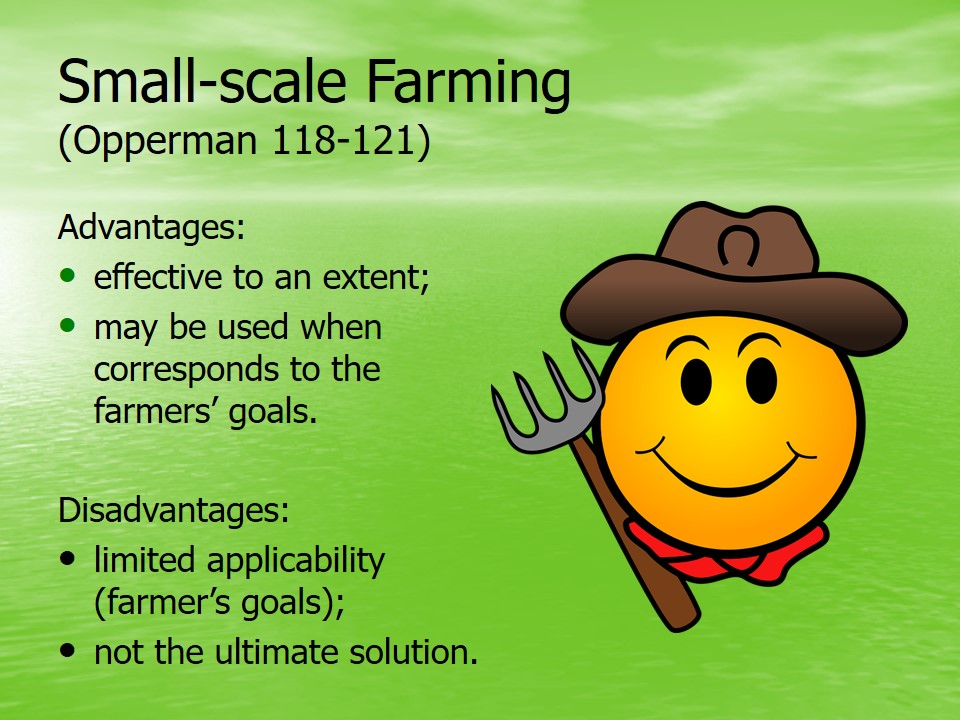
Research
- Advantages:
- intensive, not extensive;
- leads to effective agriculture.
- Disadvantages:
- costly (money, time, efforts);
- risky;
- costly to implement.
- Example: catch crops followed by irrigation (Kondo et al. 776).
Extensive measures are typically considered inferior to intensive ones. An example of the intensive approach to the issue is the agriculture research. For example, a new approach to the catch crops usage that was recently tested by Kondo et al. allows catching up to 91% of nitrogen from the soil (Kondo et al. 778-781). Environmentally friendly farming is the key to effective agriculture, but this solution is expensive and risky at the stage of development since the results of research are not guaranteed. Also, the implementation of the results of research requires money and time, and not every farmer is likely to be conscientious enough to be bothered. To help farmers to make the right choice, the government can exert its influence.
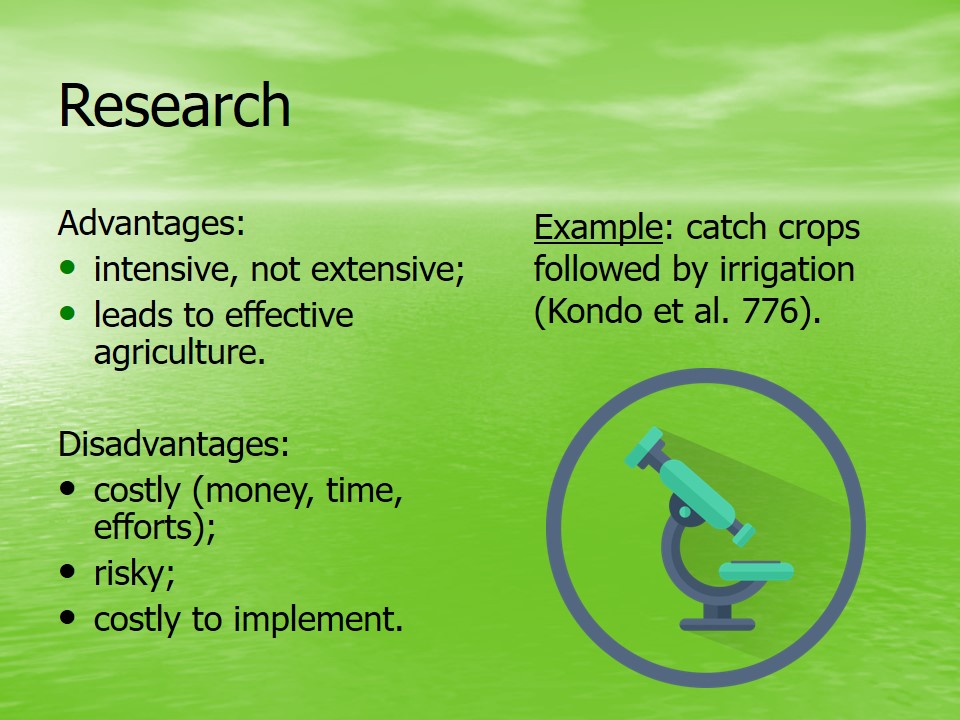
Governmental Measures
- Forms:
- standards;
- means and incentives to follow them (Bechmann et al. 102).
- Advantages:
- comprehensive;
- large-scale.
- Disadvantages:
- costly;
- accountability (Herzog et al. 665);
- limited effectiveness (population; other countries).
The government has several ways of “helping” farmers: through standards and regulations, economic incentives to follow these standards, and the means to follow them. For example, the campaign described by Bechmann et al. that is carried out in Norway includes the economic incentive of subsidies, information campaigns, and the recommendation of tools like soil erosion maps. The government has the resources to carry out a comprehensive and large-scale campaign, but these are very costly and are rarely assessed (Herzog et al. 656). Also, nutrient pollution is a global concern, and the efforts of a single country cannot fully resolve it.
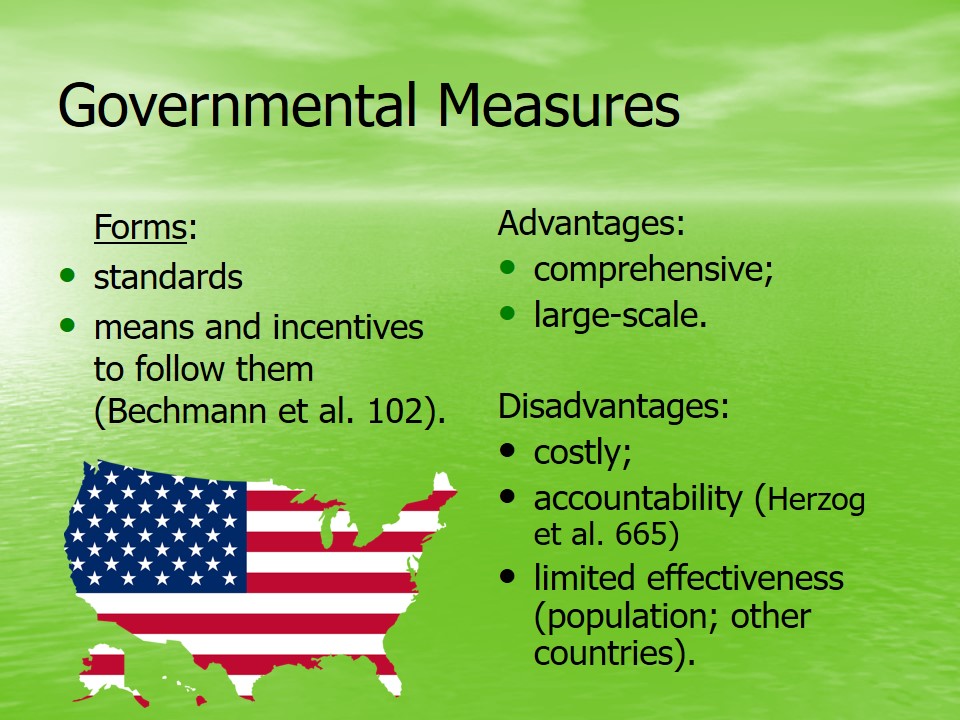
International Level
- Examples:
- OECD;
- the North Sea (Bechmann et al. 102).
- Advantage:
- the most effective.
- Disadvantages:
- the most difficult to carry out;
- different level of development;
- cooperation and consensus required.
There have been attempts to fight nutrient pollution internationally. For example, the countries that have the access to the North Sea have agreed to protect it (Bechmann et al. 102). Similarly, OECD works out plans for the reduction of nutrient pollution produced by its members (127). This solution looks like the most attractive one, but it has limitations and drawbacks as well. Not every country can contribute to the solution since they have different levels of development. Similarly, not every country may be willing to contribute: for this solution to become valid, a certain level of consensus all over the world is necessary, and it is extremely difficult to achieve.
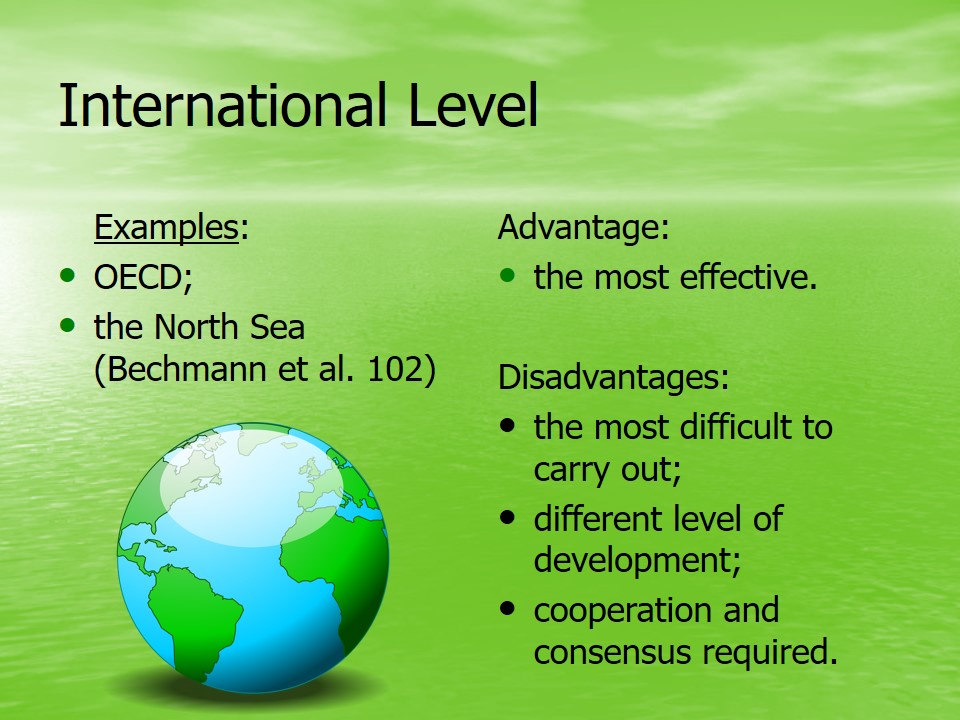
Conclusion
- Three key solutions:
- extensive means of farming improvement;
- intensive means of farming improvement;
- governmental control.
- Best-advocated solution: governmental control (Herzog et al. 656).
Therefore:
- The role of the government is central.
- The cooperation of governments is required for the resolution of the issue.
As you can see, not a single of the proposed solutions is perfect, and as a result, they are not really used on their own. Still, the most well-advocated solution is that of governmental control since the first two offer the means of resolving the problem but do not ensure their implementation. As shown by Herzog et al. farmers do not bother with either extensive or intensive solution if they do not have an extra incentive, which emphasizes the need for the control of solutions implementation (656). It logically follows that the role of the government in the reduction of nutrient pollution is central, and the cooperation of governments is apparently required for the ultimate solution if one is eventually to be achieved.
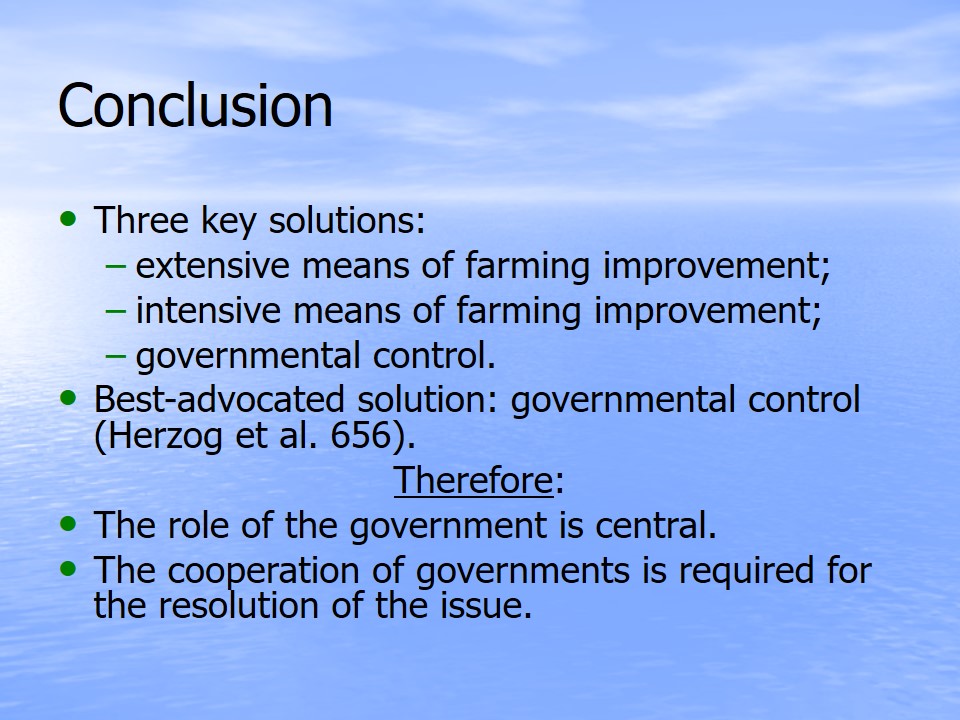
Discussion Questions
- Does it seem to you that people remain largely indifferent to environmental issues?
- What might be the psychological reasons for the farmers to remain environmentally irresponsible? Could these reasons be manipulated (affected) by the government?
- The accountability and assessment of the results of the governmental campaigns remain problematic (Herzog et al. 665). How to attract public attention to them?
- How can environmentally-savvy countries persuade less responsible ones without harming the relationships or becoming involved in completely unprofitable agreements?
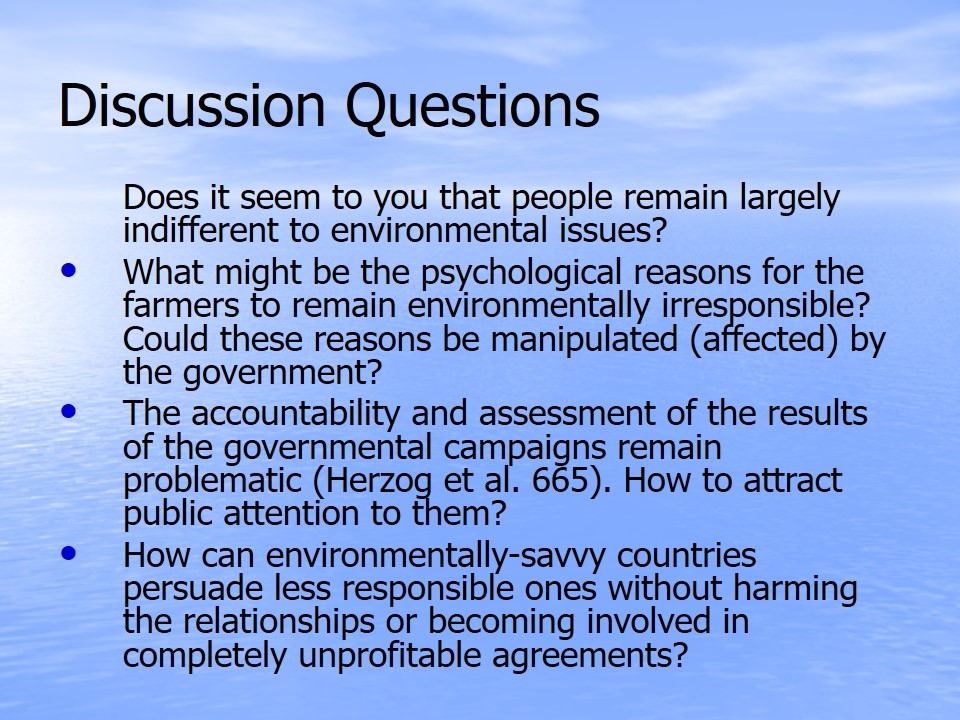
Works Cited
Bechmann, Marianne, Johannes Deelstra, Per Stalnacke, Hans Olav Eggestad, Lillian Øygarden, and Annelene Pengerud. “Monitoring Catchment Scale Agricultural Pollution In Norway: Policy Instruments, Implementation Of Mitigation Methods And Trends In Nutrient And Sediment Losses.” Environmental Science & Policy 11.2 (2008): 102-114. Elsevier. Web.
Herzog, Felix, Volker Prasuhn, Ernst Spiess, and Walter Richner. “Environmental Cross-Compliance Mitigates Nitrogen and Phosphorus Pollution from Swiss Agriculture.” Environmental Science & Policy 11.7 (2008): 655-668. Elsevier. Web.
Kondo, Kamin, Kenta Inoue, Tomi Fujiwara, Shinzo Yamane, Daisuke Yasutake, Morihiro Maeda, Hideaki Nagare, Satoshi Akao, and Kunio Ohtoshi. “Seasonal Changes in the Performance of a Catch Crop for Mitigating Diffuse Agricultural Pollution.” Water Science and Technology: A Journal of the International Association on Water Pollution Research 68.4 (2013): 776-782. EBSCOhost. Web.
OECD. OECD Compendium of Agri-Environmental Indicators. OECD Publications Centre, 2013. Print.
Opperman, Jeff. ” Getting to Know Your Bacon: Hogs, Farms and Clean Water.” Sustainability: A Reader for Writers. Ed. Carl George Herndl. Oxford: Oxford University Press, 2013. 118-121. Print.